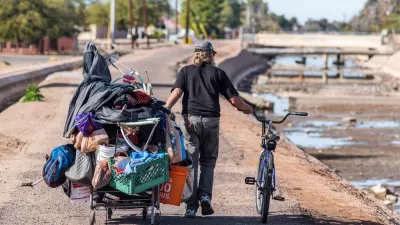A groundbreaking study provides some of the strongest evidence yet of the powerful results of permanent supportive housing for the chronically homeless.

Marisa Kendall shares news on a new study by researchers at the University of California, San Francisco (UCSF) that reveals big successes for Project Welcome Home in housing chronically homeless residents of Santa Clara County.
"The first-of-its-kind study found 86% of participants received housing and then stayed housed throughout nearly the entire duration of the study," reports Kendall.
The UCSF research team says that these findings are groundbreaking "because they show that permanent supportive housing — which provides subsidized housing paired with counseling, mental health, addiction and other services — is helping the county’s most difficult cases," according to Kendall.
Project Welcome Home is a $19 million project that used a lottery system between 2015 and 2019 to provide housing for the chronically homeless. The participants in the program were offered counseling, addiction treatment, and other help from the nonprofit Abode Services.
The results of the study do come with the caveat that supportive housing, while effective in this program, is not a silver bullet. "Seventy of the 443 participants died during the course of the study, including 19% of those who received housing," according to Kendall, who also lists other caveats.
The source article includes a lot more details on Project Welcome Home, the study's methodologies and findings, and the implications of the study for homeless policies in the Bay Area and state of California.
FULL STORY: ‘It works.’ Groundbreaking data proves success of Santa Clara County homeless housing program

Alabama: Trump Terminates Settlements for Black Communities Harmed By Raw Sewage
Trump deemed the landmark civil rights agreement “illegal DEI and environmental justice policy.”

Planetizen Federal Action Tracker
A weekly monitor of how Trump’s orders and actions are impacting planners and planning in America.

The 120 Year Old Tiny Home Villages That Sheltered San Francisco’s Earthquake Refugees
More than a century ago, San Francisco mobilized to house thousands of residents displaced by the 1906 earthquake. Could their strategy offer a model for the present?

In Both Crashes and Crime, Public Transportation is Far Safer than Driving
Contrary to popular assumptions, public transportation has far lower crash and crime rates than automobile travel. For safer communities, improve and encourage transit travel.

Report: Zoning Reforms Should Complement Nashville’s Ambitious Transit Plan
Without reform, restrictive zoning codes will limit the impact of the city’s planned transit expansion and could exclude some of the residents who depend on transit the most.

Judge Orders Release of Frozen IRA, IIJA Funding
The decision is a victory for environmental groups who charged that freezing funds for critical infrastructure and disaster response programs caused “real and irreparable harm” to communities.
Urban Design for Planners 1: Software Tools
This six-course series explores essential urban design concepts using open source software and equips planners with the tools they need to participate fully in the urban design process.
Planning for Universal Design
Learn the tools for implementing Universal Design in planning regulations.
Clanton & Associates, Inc.
Jessamine County Fiscal Court
Institute for Housing and Urban Development Studies (IHS)
City of Grandview
Harvard GSD Executive Education
Toledo-Lucas County Plan Commissions
Salt Lake City
NYU Wagner Graduate School of Public Service





























